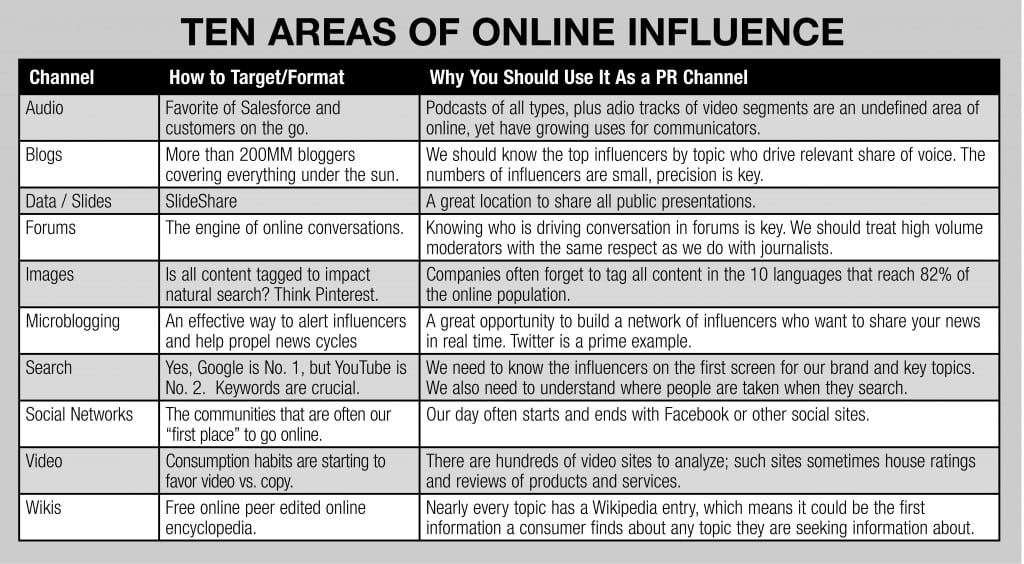
We are often asked our view on the newest social channel, whether it is Vine or What’s App or Vube. Our response is always the same: Where are our customers? The advertising industry created the idea of “media planning.” Their job is to identify the best media outlets to share a brand’s story via paid media. It’s a relatively easy concept, since it is generally based on reach and frequency. My how the world has changed.
In today’s world, advertising is evolving towards ‘storytizing,’ which is driven by earned media, not paid. In earned media, our customers are deciding what is relevant, what they will share and whether they will, quite frankly, pay attention. Reach and frequency are being replaced by engagement and passion, which are far better indicators of shaping behavior and driving sales.
The result is that PR pros and communicators have an opportunity to create the first earned media plans, which tell us where we should invest our time and money. Here is how we can make this happen.
The most important point is that there are only ten types of online media. They include audio, video, forums, blogs, search, social media sites, micro-blogs, images, data/slides and Wikis. Here are the four keys to earned media plans.
1. Rank the ten channels. How many articles, videos, conversations or searches occur by channel? Once you get an aggregate number for each channel by topic, you can then stack-rank the channels. What’s interesting is that when you focus on a topic, e.g. “Brand X” vs. the larger topic, e.g. “nutrition,” you’ll find that the larger category topic is at least 40x higher in volume than your brand, on average.
You now know where the customers are for your category and for your brand and you have a priority order of channels from 1-10.
Note: Remember that the priority order of channels will change by country, topic, issue and brand.
2. Role of channel. Each channel plays a very specific role. Slideshare, which has more than 100 million unique visitors per month, is the top place to access PowerPoints. Customers who want to learn go there often.

Forums are often where communities are teaching each other about topics. Videos are our favorite way to absorb new information, since our brains prefer to learn this way. Search is what we do when we have a question and aren’t sure where to go, often in the beginning of our journey. Wikis are our new Encyclopedia Britannica’s. You get the picture.
Each channel serves a different purpose. We may want to start a conversation on Twitter and link to a slide deck on Slideshare to see if we can get our customers to learn more on a key topic. The key is we start thinking of several steps taken by the customer that shape behavior, not just one.
Note: Ask yourself what the journey is like for a customer to go from zero knowledge to buying your product. What content is important at each step of the journey?
3. Customer need by channel. Our customers want us to have the equivalent of a conversation with them. Even if we don’t really converse, they want to at least know that we understand their needs. For example, if we are on YouTube, most of us go there to either entertain ourselves or to answer a question.
So if you share videos, answer your customers’ questions and then move on. Don’t try to be an entertainer unless you are amazing at it. Avoid slick corporate videos. If you are on SlideShare, you want to see slides that teach you something you didn’t know.
If you are on Facebook, know who you are trying to reach. If you are sharing images that appeal to men and you’re trying to reach women, you’ll turn away your audience. Those types of tiny details show whether you actually know your audience or not. Customers won’t complain, they’ll just avoid channels that don’t get who they are.
Note: Imagine the journey of your customer. Where do they learn first about your brand (search), where do they go to learn (video or SlideShare), where do they talk with their peers (forums) and where do they get subtly influenced by their peers every day (Facebook).
4. Time commitment. You’re not spending money, in most cases, for media. But earned media is an apt title. You do “earn it” by being present, engaging in conversations, sharing relevant information and answering questions the best you can.
It takes a dedicated person or team to do this well. And you need to talk continually about what is working, so you keep getting better at how to reach customers for each channel.
Note: Focus on understanding what excellence is like in each channel for your brand. What works and why? What never works and why?
The result is that you can identify which channels matter for your brand. You can focus on where your customers are and invest your limited time and money into the places with the highest ROI.
You can also tell those folks who randomly ask for a channel to be built that it’s a bad idea if your customers aren’t there in mass, and simply smile, show the data and go to your next meeting.
CONTACT:
Bob Pearson is President of W20 Group. He can be reached at [email protected].
This article originally appeared in the May 26, 2014 issue of PR News. Read more subscriber-only content by becoming a PR News subscriber today.

One response to “Developing an ‘Earned’ Media Plan”